Strengthening the Domestic and Family Violence Workforce: Key Questions | Australian Social Work.
VerifiedAdded on 2022/08/20
|10
|5440
|15
AI Summary
Contribute Materials
Your contribution can guide someone’s learning journey. Share your
documents today.
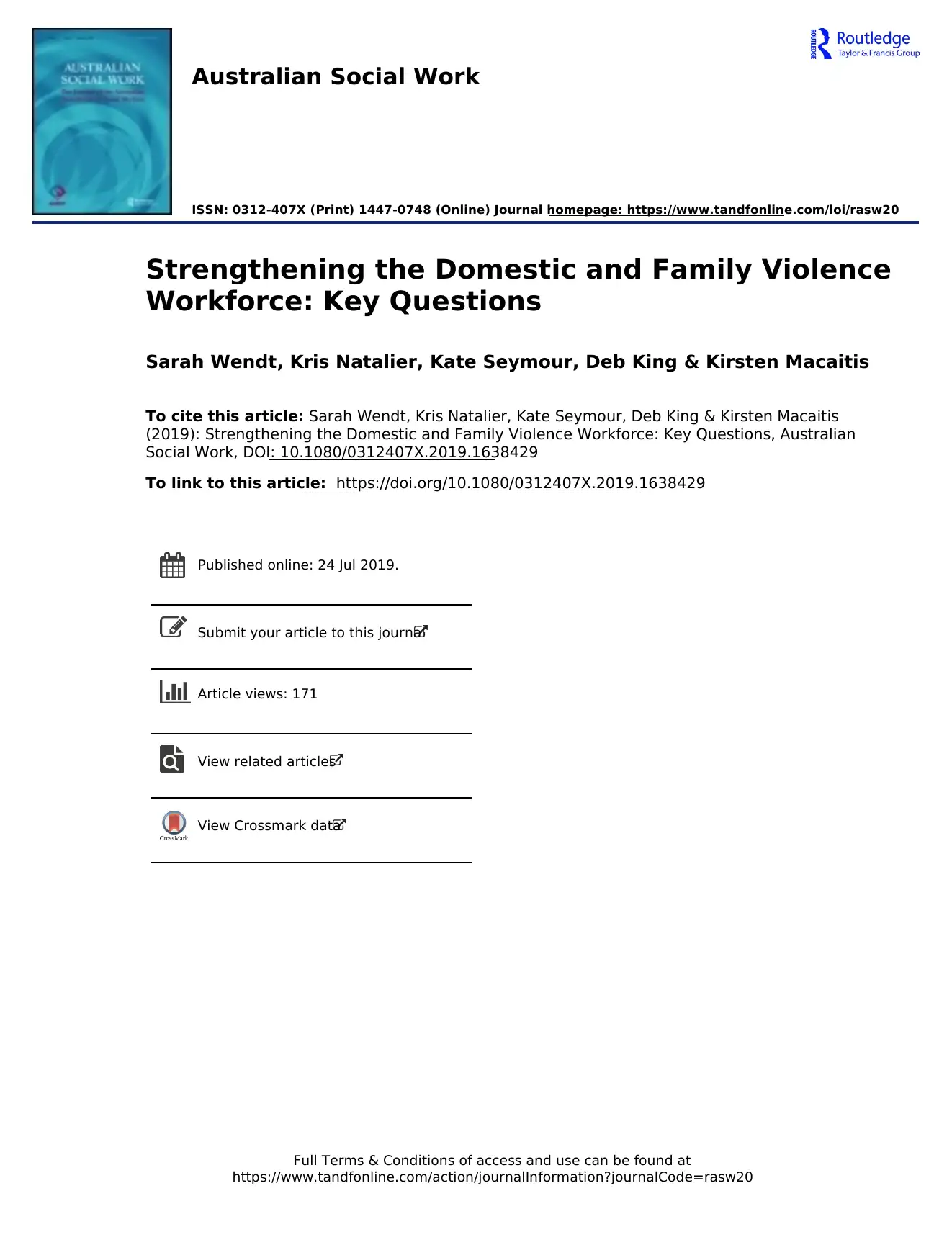
Full Terms & Conditions of access and use can be found at
https://www.tandfonline.com/action/journalInformation?journalCode=rasw20
Australian Social Work
ISSN: 0312-407X (Print) 1447-0748 (Online) Journal homepage: https://www.tandfonline.com/loi/rasw20
Strengthening the Domestic and Family Violence
Workforce: Key Questions
Sarah Wendt, Kris Natalier, Kate Seymour, Deb King & Kirsten Macaitis
To cite this article: Sarah Wendt, Kris Natalier, Kate Seymour, Deb King & Kirsten Macaitis
(2019): Strengthening the Domestic and Family Violence Workforce: Key Questions, Australian
Social Work, DOI: 10.1080/0312407X.2019.1638429
To link to this article: https://doi.org/10.1080/0312407X.2019.1638429
Published online: 24 Jul 2019.
Submit your article to this journal
Article views: 171
View related articles
View Crossmark data
https://www.tandfonline.com/action/journalInformation?journalCode=rasw20
Australian Social Work
ISSN: 0312-407X (Print) 1447-0748 (Online) Journal homepage: https://www.tandfonline.com/loi/rasw20
Strengthening the Domestic and Family Violence
Workforce: Key Questions
Sarah Wendt, Kris Natalier, Kate Seymour, Deb King & Kirsten Macaitis
To cite this article: Sarah Wendt, Kris Natalier, Kate Seymour, Deb King & Kirsten Macaitis
(2019): Strengthening the Domestic and Family Violence Workforce: Key Questions, Australian
Social Work, DOI: 10.1080/0312407X.2019.1638429
To link to this article: https://doi.org/10.1080/0312407X.2019.1638429
Published online: 24 Jul 2019.
Submit your article to this journal
Article views: 171
View related articles
View Crossmark data
Secure Best Marks with AI Grader
Need help grading? Try our AI Grader for instant feedback on your assignments.
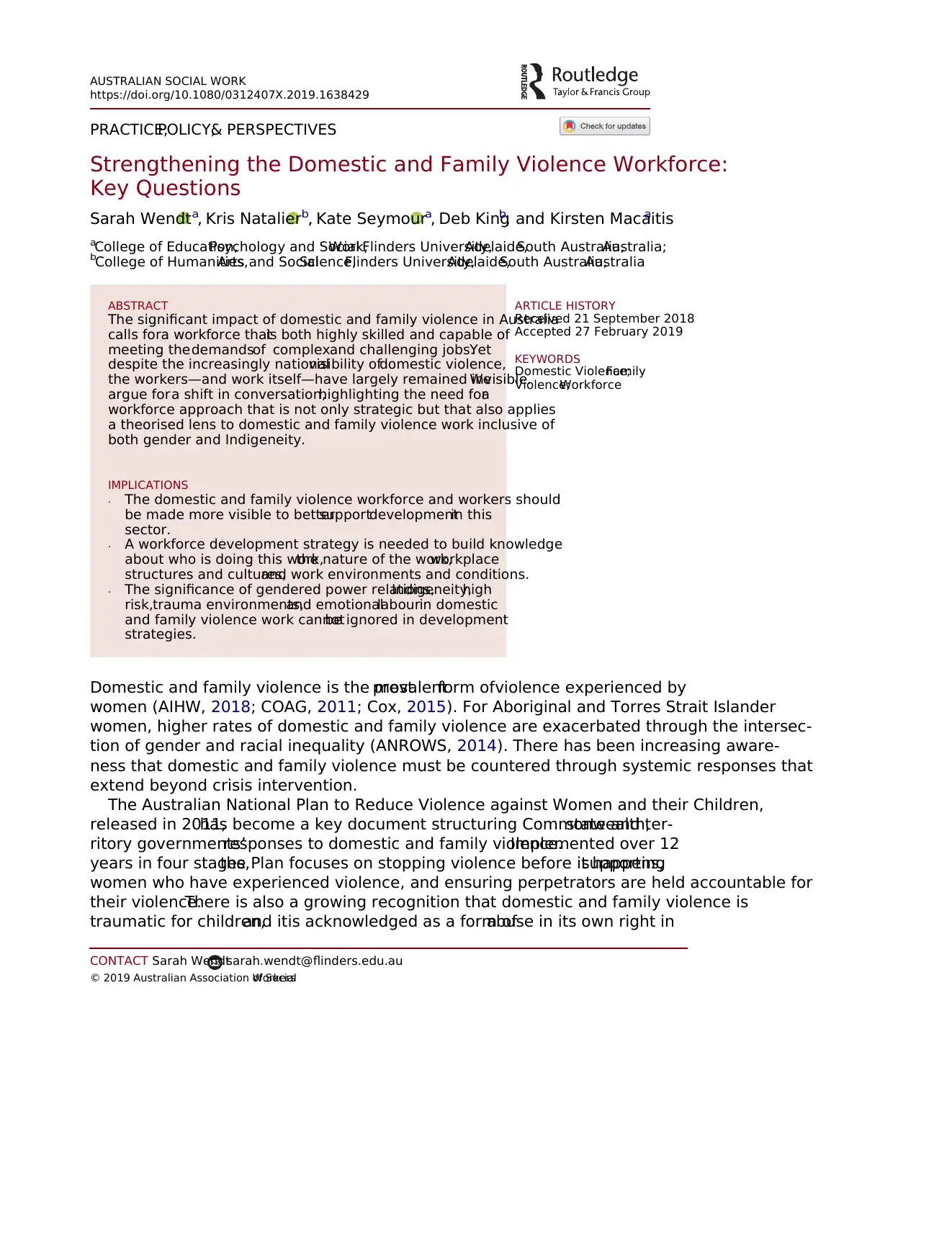
PRACTICE,POLICY,& PERSPECTIVES
Strengthening the Domestic and Family Violence Workforce:
Key Questions
Sarah Wendt a, Kris Natalierb, Kate Seymoura, Deb Kingb, and Kirsten Macaitisa
aCollege of Education,Psychology and SocialWork,Flinders University,Adelaide,South Australia,Australia;
bCollege of Humanities,Arts and SocialScience,Flinders University,Adelaide,South Australia,Australia
ABSTRACT
The significant impact of domestic and family violence in Australia
calls fora workforce thatis both highly skilled and capable of
meeting thedemandsof complexand challenging jobs.Yet
despite the increasingly nationalvisibility ofdomestic violence,
the workers—and work itself—have largely remained invisible.We
argue fora shift in conversation,highlighting the need fora
workforce approach that is not only strategic but that also applies
a theorised lens to domestic and family violence work inclusive of
both gender and Indigeneity.
IMPLICATIONS
. The domestic and family violence workforce and workers should
be made more visible to bettersupportdevelopmentin this
sector.
. A workforce development strategy is needed to build knowledge
about who is doing this work,the nature of the work,workplace
structures and cultures,and work environments and conditions.
. The significance of gendered power relations,Indigeneity,high
risk,trauma environments,and emotionallabourin domestic
and family violence work cannotbe ignored in development
strategies.
ARTICLE HISTORY
Received 21 September 2018
Accepted 27 February 2019
KEYWORDS
Domestic Violence;Family
Violence;Workforce
Domestic and family violence is the mostprevalentform ofviolence experienced by
women (AIHW, 2018; COAG, 2011; Cox, 2015). For Aboriginal and Torres Strait Islander
women, higher rates of domestic and family violence are exacerbated through the intersec-
tion of gender and racial inequality (ANROWS, 2014). There has been increasing aware-
ness that domestic and family violence must be countered through systemic responses that
extend beyond crisis intervention.
The Australian National Plan to Reduce Violence against Women and their Children,
released in 2011,has become a key document structuring Commonwealth,state and ter-
ritory governments’responses to domestic and family violence.Implemented over 12
years in four stages,the Plan focuses on stopping violence before it happens,supporting
women who have experienced violence, and ensuring perpetrators are held accountable for
their violence.There is also a growing recognition that domestic and family violence is
traumatic for children,and itis acknowledged as a form ofabuse in its own right in
© 2019 Australian Association of SocialWorkers
CONTACT Sarah Wendtsarah.wendt@flinders.edu.au
AUSTRALIAN SOCIAL WORK
https://doi.org/10.1080/0312407X.2019.1638429
Strengthening the Domestic and Family Violence Workforce:
Key Questions
Sarah Wendt a, Kris Natalierb, Kate Seymoura, Deb Kingb, and Kirsten Macaitisa
aCollege of Education,Psychology and SocialWork,Flinders University,Adelaide,South Australia,Australia;
bCollege of Humanities,Arts and SocialScience,Flinders University,Adelaide,South Australia,Australia
ABSTRACT
The significant impact of domestic and family violence in Australia
calls fora workforce thatis both highly skilled and capable of
meeting thedemandsof complexand challenging jobs.Yet
despite the increasingly nationalvisibility ofdomestic violence,
the workers—and work itself—have largely remained invisible.We
argue fora shift in conversation,highlighting the need fora
workforce approach that is not only strategic but that also applies
a theorised lens to domestic and family violence work inclusive of
both gender and Indigeneity.
IMPLICATIONS
. The domestic and family violence workforce and workers should
be made more visible to bettersupportdevelopmentin this
sector.
. A workforce development strategy is needed to build knowledge
about who is doing this work,the nature of the work,workplace
structures and cultures,and work environments and conditions.
. The significance of gendered power relations,Indigeneity,high
risk,trauma environments,and emotionallabourin domestic
and family violence work cannotbe ignored in development
strategies.
ARTICLE HISTORY
Received 21 September 2018
Accepted 27 February 2019
KEYWORDS
Domestic Violence;Family
Violence;Workforce
Domestic and family violence is the mostprevalentform ofviolence experienced by
women (AIHW, 2018; COAG, 2011; Cox, 2015). For Aboriginal and Torres Strait Islander
women, higher rates of domestic and family violence are exacerbated through the intersec-
tion of gender and racial inequality (ANROWS, 2014). There has been increasing aware-
ness that domestic and family violence must be countered through systemic responses that
extend beyond crisis intervention.
The Australian National Plan to Reduce Violence against Women and their Children,
released in 2011,has become a key document structuring Commonwealth,state and ter-
ritory governments’responses to domestic and family violence.Implemented over 12
years in four stages,the Plan focuses on stopping violence before it happens,supporting
women who have experienced violence, and ensuring perpetrators are held accountable for
their violence.There is also a growing recognition that domestic and family violence is
traumatic for children,and itis acknowledged as a form ofabuse in its own right in
© 2019 Australian Association of SocialWorkers
CONTACT Sarah Wendtsarah.wendt@flinders.edu.au
AUSTRALIAN SOCIAL WORK
https://doi.org/10.1080/0312407X.2019.1638429
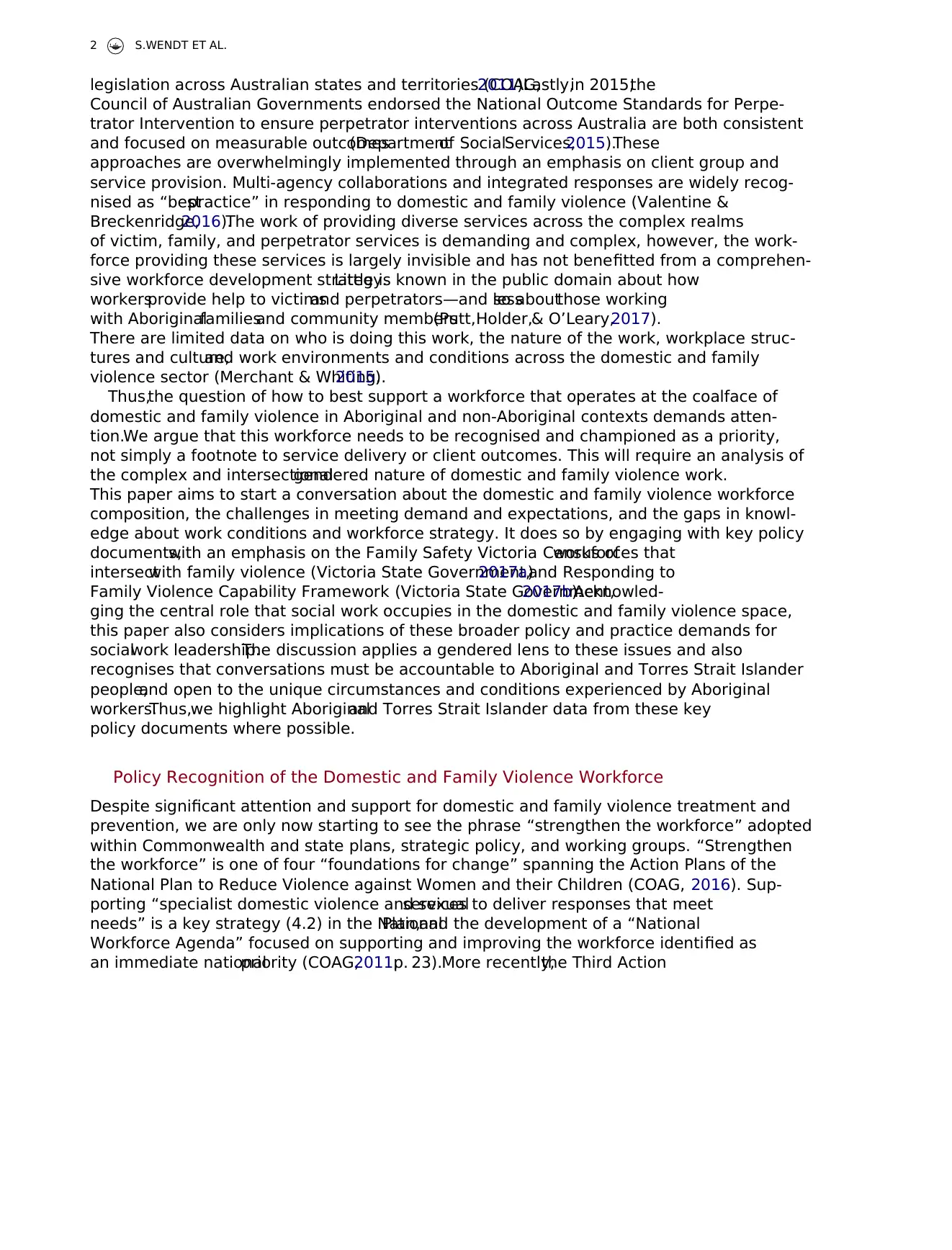
legislation across Australian states and territories (COAG,2011).Lastly,in 2015,the
Council of Australian Governments endorsed the National Outcome Standards for Perpe-
trator Intervention to ensure perpetrator interventions across Australia are both consistent
and focused on measurable outcomes(Departmentof SocialServices,2015).These
approaches are overwhelmingly implemented through an emphasis on client group and
service provision. Multi-agency collaborations and integrated responses are widely recog-
nised as “bestpractice” in responding to domestic and family violence (Valentine &
Breckenridge,2016).The work of providing diverse services across the complex realms
of victim, family, and perpetrator services is demanding and complex, however, the work-
force providing these services is largely invisible and has not benefitted from a comprehen-
sive workforce development strategy.Little is known in the public domain about how
workersprovide help to victimsand perpetrators—and lessso aboutthose working
with Aboriginalfamiliesand community members(Putt,Holder,& O’Leary,2017).
There are limited data on who is doing this work, the nature of the work, workplace struc-
tures and culture,and work environments and conditions across the domestic and family
violence sector (Merchant & Whiting,2015).
Thus,the question of how to best support a workforce that operates at the coalface of
domestic and family violence in Aboriginal and non-Aboriginal contexts demands atten-
tion.We argue that this workforce needs to be recognised and championed as a priority,
not simply a footnote to service delivery or client outcomes. This will require an analysis of
the complex and intersectionalgendered nature of domestic and family violence work.
This paper aims to start a conversation about the domestic and family violence workforce
composition, the challenges in meeting demand and expectations, and the gaps in knowl-
edge about work conditions and workforce strategy. It does so by engaging with key policy
documents,with an emphasis on the Family Safety Victoria Census ofworkforces that
intersectwith family violence (Victoria State Government,2017a)and Responding to
Family Violence Capability Framework (Victoria State Government,2017b).Acknowled-
ging the central role that social work occupies in the domestic and family violence space,
this paper also considers implications of these broader policy and practice demands for
socialwork leadership.The discussion applies a gendered lens to these issues and also
recognises that conversations must be accountable to Aboriginal and Torres Strait Islander
people,and open to the unique circumstances and conditions experienced by Aboriginal
workers.Thus,we highlight Aboriginaland Torres Strait Islander data from these key
policy documents where possible.
Policy Recognition of the Domestic and Family Violence Workforce
Despite significant attention and support for domestic and family violence treatment and
prevention, we are only now starting to see the phrase “strengthen the workforce” adopted
within Commonwealth and state plans, strategic policy, and working groups. “Strengthen
the workforce” is one of four “foundations for change” spanning the Action Plans of the
National Plan to Reduce Violence against Women and their Children (COAG, 2016). Sup-
porting “specialist domestic violence and sexualservices to deliver responses that meet
needs” is a key strategy (4.2) in the NationalPlan,and the development of a “National
Workforce Agenda” focused on supporting and improving the workforce identified as
an immediate nationalpriority (COAG,2011,p. 23).More recently,the Third Action
2 S.WENDT ET AL.
Council of Australian Governments endorsed the National Outcome Standards for Perpe-
trator Intervention to ensure perpetrator interventions across Australia are both consistent
and focused on measurable outcomes(Departmentof SocialServices,2015).These
approaches are overwhelmingly implemented through an emphasis on client group and
service provision. Multi-agency collaborations and integrated responses are widely recog-
nised as “bestpractice” in responding to domestic and family violence (Valentine &
Breckenridge,2016).The work of providing diverse services across the complex realms
of victim, family, and perpetrator services is demanding and complex, however, the work-
force providing these services is largely invisible and has not benefitted from a comprehen-
sive workforce development strategy.Little is known in the public domain about how
workersprovide help to victimsand perpetrators—and lessso aboutthose working
with Aboriginalfamiliesand community members(Putt,Holder,& O’Leary,2017).
There are limited data on who is doing this work, the nature of the work, workplace struc-
tures and culture,and work environments and conditions across the domestic and family
violence sector (Merchant & Whiting,2015).
Thus,the question of how to best support a workforce that operates at the coalface of
domestic and family violence in Aboriginal and non-Aboriginal contexts demands atten-
tion.We argue that this workforce needs to be recognised and championed as a priority,
not simply a footnote to service delivery or client outcomes. This will require an analysis of
the complex and intersectionalgendered nature of domestic and family violence work.
This paper aims to start a conversation about the domestic and family violence workforce
composition, the challenges in meeting demand and expectations, and the gaps in knowl-
edge about work conditions and workforce strategy. It does so by engaging with key policy
documents,with an emphasis on the Family Safety Victoria Census ofworkforces that
intersectwith family violence (Victoria State Government,2017a)and Responding to
Family Violence Capability Framework (Victoria State Government,2017b).Acknowled-
ging the central role that social work occupies in the domestic and family violence space,
this paper also considers implications of these broader policy and practice demands for
socialwork leadership.The discussion applies a gendered lens to these issues and also
recognises that conversations must be accountable to Aboriginal and Torres Strait Islander
people,and open to the unique circumstances and conditions experienced by Aboriginal
workers.Thus,we highlight Aboriginaland Torres Strait Islander data from these key
policy documents where possible.
Policy Recognition of the Domestic and Family Violence Workforce
Despite significant attention and support for domestic and family violence treatment and
prevention, we are only now starting to see the phrase “strengthen the workforce” adopted
within Commonwealth and state plans, strategic policy, and working groups. “Strengthen
the workforce” is one of four “foundations for change” spanning the Action Plans of the
National Plan to Reduce Violence against Women and their Children (COAG, 2016). Sup-
porting “specialist domestic violence and sexualservices to deliver responses that meet
needs” is a key strategy (4.2) in the NationalPlan,and the development of a “National
Workforce Agenda” focused on supporting and improving the workforce identified as
an immediate nationalpriority (COAG,2011,p. 23).More recently,the Third Action
2 S.WENDT ET AL.
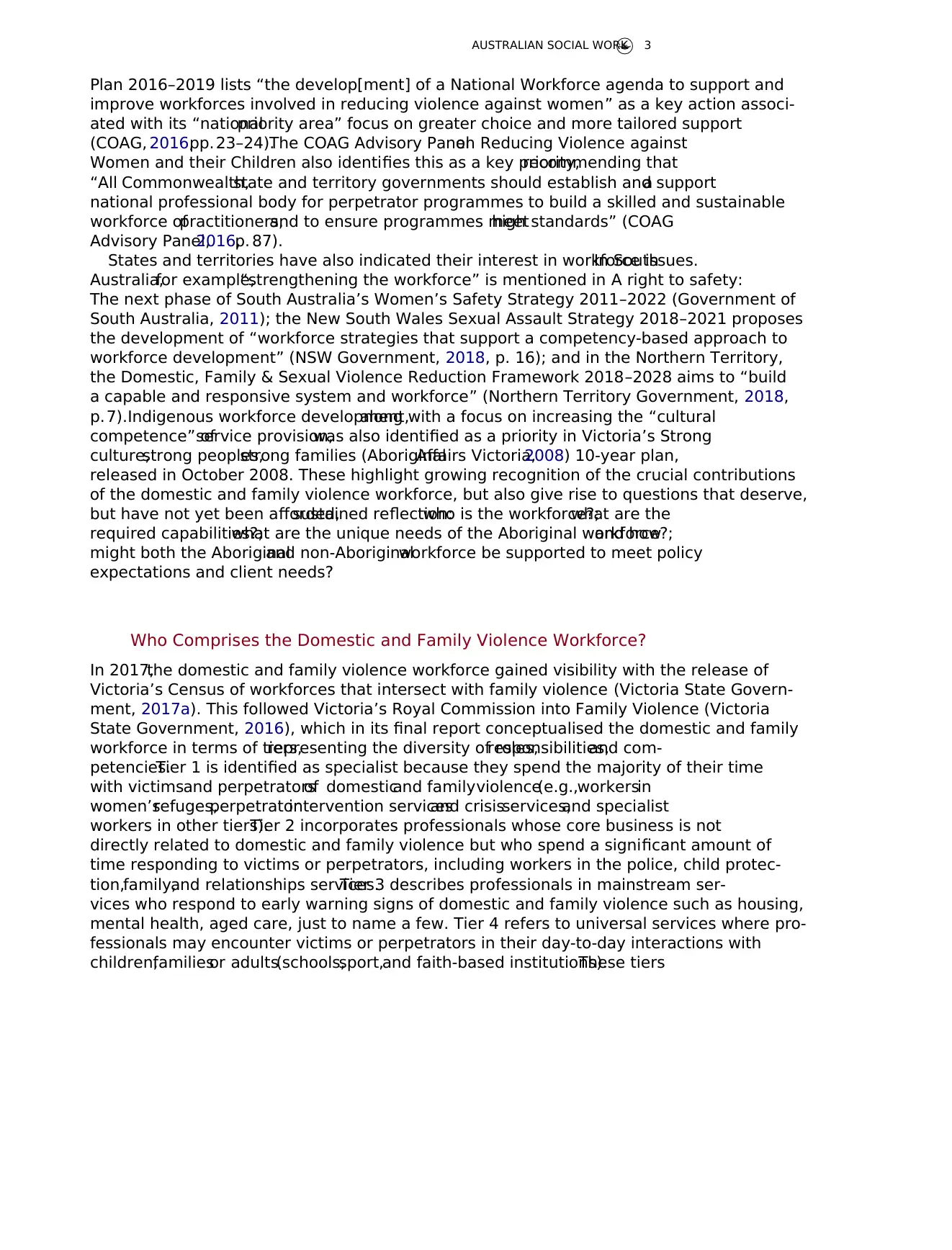
Plan 2016–2019 lists “the develop[ment] of a National Workforce agenda to support and
improve workforces involved in reducing violence against women” as a key action associ-
ated with its “nationalpriority area” focus on greater choice and more tailored support
(COAG, 2016,pp.23–24).The COAG Advisory Panelon Reducing Violence against
Women and their Children also identifies this as a key priority,recommending that
“All Commonwealth,state and territory governments should establish and supporta
national professional body for perpetrator programmes to build a skilled and sustainable
workforce ofpractitioners,and to ensure programmes meethigh standards” (COAG
Advisory Panel,2016,p. 87).
States and territories have also indicated their interest in workforce issues.In South
Australia,for example,“strengthening the workforce” is mentioned in A right to safety:
The next phase of South Australia’s Women’s Safety Strategy 2011–2022 (Government of
South Australia, 2011); the New South Wales Sexual Assault Strategy 2018–2021 proposes
the development of “workforce strategies that support a competency-based approach to
workforce development” (NSW Government, 2018, p. 16); and in the Northern Territory,
the Domestic, Family & Sexual Violence Reduction Framework 2018–2028 aims to “build
a capable and responsive system and workforce” (Northern Territory Government, 2018,
p. 7).Indigenous workforce development,along with a focus on increasing the “cultural
competence” ofservice provision,was also identified as a priority in Victoria’s Strong
culture,strong peoples,strong families (AboriginalAffairs Victoria,2008) 10-year plan,
released in October 2008. These highlight growing recognition of the crucial contributions
of the domestic and family violence workforce, but also give rise to questions that deserve,
but have not yet been afforded,sustained reflection:who is the workforce?;what are the
required capabilities?;what are the unique needs of the Aboriginal workforce?;and how
might both the Aboriginaland non-Aboriginalworkforce be supported to meet policy
expectations and client needs?
Who Comprises the Domestic and Family Violence Workforce?
In 2017,the domestic and family violence workforce gained visibility with the release of
Victoria’s Census of workforces that intersect with family violence (Victoria State Govern-
ment, 2017a). This followed Victoria’s Royal Commission into Family Violence (Victoria
State Government, 2016), which in its final report conceptualised the domestic and family
workforce in terms of tiers,representing the diversity of roles,responsibilities,and com-
petencies.Tier 1 is identified as specialist because they spend the majority of their time
with victimsand perpetratorsof domesticand familyviolence(e.g.,workersin
women’srefuges,perpetratorintervention servicesand crisisservices,and specialist
workers in other tiers).Tier 2 incorporates professionals whose core business is not
directly related to domestic and family violence but who spend a significant amount of
time responding to victims or perpetrators, including workers in the police, child protec-
tion,family,and relationships services.Tier 3 describes professionals in mainstream ser-
vices who respond to early warning signs of domestic and family violence such as housing,
mental health, aged care, just to name a few. Tier 4 refers to universal services where pro-
fessionals may encounter victims or perpetrators in their day-to-day interactions with
children,familiesor adults(schools,sport,and faith-based institutions).These tiers
AUSTRALIAN SOCIAL WORK 3
improve workforces involved in reducing violence against women” as a key action associ-
ated with its “nationalpriority area” focus on greater choice and more tailored support
(COAG, 2016,pp.23–24).The COAG Advisory Panelon Reducing Violence against
Women and their Children also identifies this as a key priority,recommending that
“All Commonwealth,state and territory governments should establish and supporta
national professional body for perpetrator programmes to build a skilled and sustainable
workforce ofpractitioners,and to ensure programmes meethigh standards” (COAG
Advisory Panel,2016,p. 87).
States and territories have also indicated their interest in workforce issues.In South
Australia,for example,“strengthening the workforce” is mentioned in A right to safety:
The next phase of South Australia’s Women’s Safety Strategy 2011–2022 (Government of
South Australia, 2011); the New South Wales Sexual Assault Strategy 2018–2021 proposes
the development of “workforce strategies that support a competency-based approach to
workforce development” (NSW Government, 2018, p. 16); and in the Northern Territory,
the Domestic, Family & Sexual Violence Reduction Framework 2018–2028 aims to “build
a capable and responsive system and workforce” (Northern Territory Government, 2018,
p. 7).Indigenous workforce development,along with a focus on increasing the “cultural
competence” ofservice provision,was also identified as a priority in Victoria’s Strong
culture,strong peoples,strong families (AboriginalAffairs Victoria,2008) 10-year plan,
released in October 2008. These highlight growing recognition of the crucial contributions
of the domestic and family violence workforce, but also give rise to questions that deserve,
but have not yet been afforded,sustained reflection:who is the workforce?;what are the
required capabilities?;what are the unique needs of the Aboriginal workforce?;and how
might both the Aboriginaland non-Aboriginalworkforce be supported to meet policy
expectations and client needs?
Who Comprises the Domestic and Family Violence Workforce?
In 2017,the domestic and family violence workforce gained visibility with the release of
Victoria’s Census of workforces that intersect with family violence (Victoria State Govern-
ment, 2017a). This followed Victoria’s Royal Commission into Family Violence (Victoria
State Government, 2016), which in its final report conceptualised the domestic and family
workforce in terms of tiers,representing the diversity of roles,responsibilities,and com-
petencies.Tier 1 is identified as specialist because they spend the majority of their time
with victimsand perpetratorsof domesticand familyviolence(e.g.,workersin
women’srefuges,perpetratorintervention servicesand crisisservices,and specialist
workers in other tiers).Tier 2 incorporates professionals whose core business is not
directly related to domestic and family violence but who spend a significant amount of
time responding to victims or perpetrators, including workers in the police, child protec-
tion,family,and relationships services.Tier 3 describes professionals in mainstream ser-
vices who respond to early warning signs of domestic and family violence such as housing,
mental health, aged care, just to name a few. Tier 4 refers to universal services where pro-
fessionals may encounter victims or perpetrators in their day-to-day interactions with
children,familiesor adults(schools,sport,and faith-based institutions).These tiers
AUSTRALIAN SOCIAL WORK 3
Secure Best Marks with AI Grader
Need help grading? Try our AI Grader for instant feedback on your assignments.
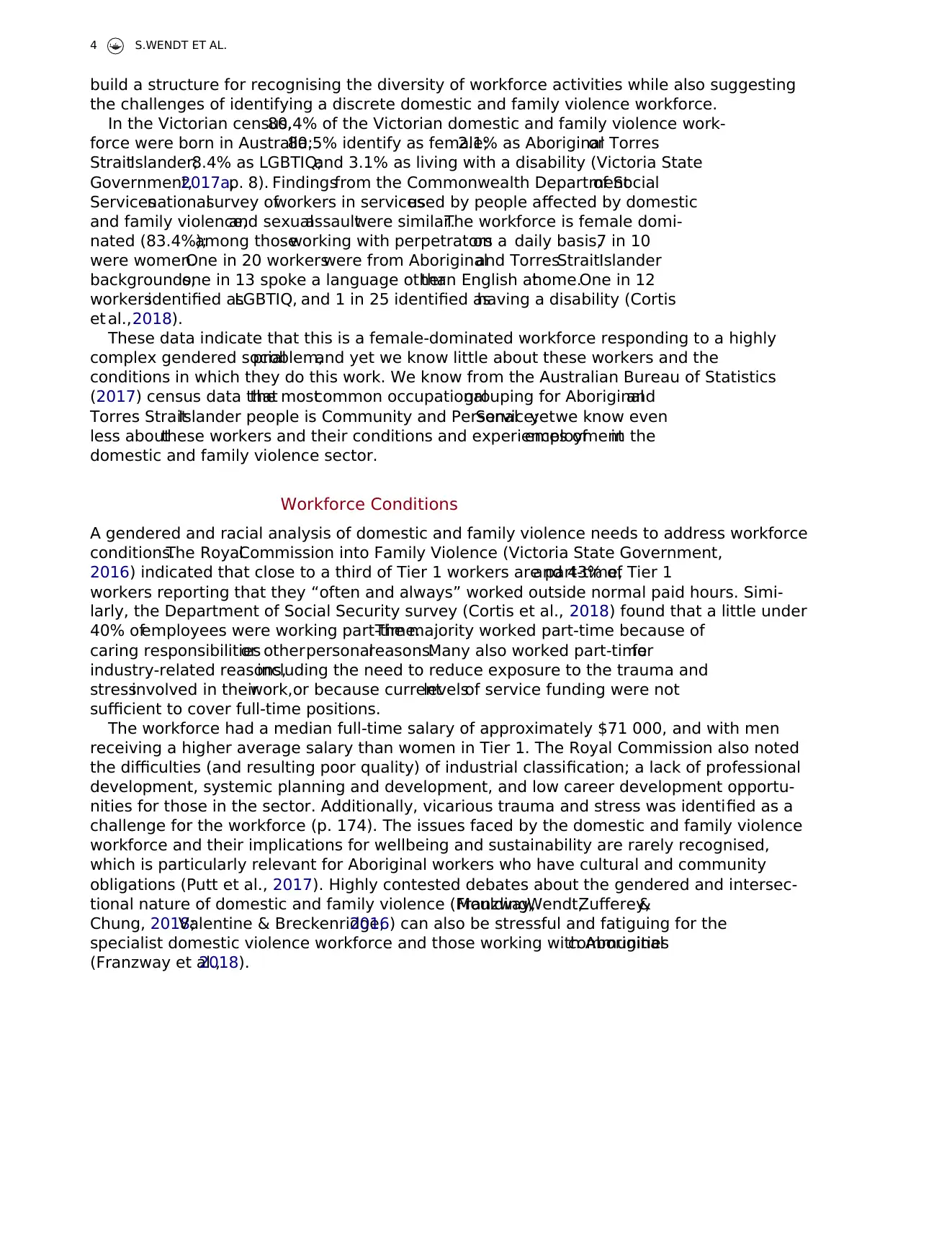
build a structure for recognising the diversity of workforce activities while also suggesting
the challenges of identifying a discrete domestic and family violence workforce.
In the Victorian census,80.4% of the Victorian domestic and family violence work-
force were born in Australia;80.5% identify as female;2.1% as Aboriginalor Torres
StraitIslander;8.4% as LGBTIQ;and 3.1% as living with a disability (Victoria State
Government,2017a,p. 8). Findingsfrom the Commonwealth Departmentof Social
Servicesnationalsurvey ofworkers in servicesused by people affected by domestic
and family violence,and sexualassaultwere similar.The workforce is female domi-
nated (83.4%);among thoseworking with perpetratorson a daily basis,7 in 10
were women.One in 20 workerswere from Aboriginaland TorresStraitIslander
backgrounds;one in 13 spoke a language otherthan English athome.One in 12
workersidentified asLGBTIQ, and 1 in 25 identified ashaving a disability (Cortis
et al.,2018).
These data indicate that this is a female-dominated workforce responding to a highly
complex gendered socialproblem,and yet we know little about these workers and the
conditions in which they do this work. We know from the Australian Bureau of Statistics
(2017) census data thatthe mostcommon occupationalgrouping for Aboriginaland
Torres StraitIslander people is Community and PersonalService;yetwe know even
less aboutthese workers and their conditions and experiences ofemploymentin the
domestic and family violence sector.
Workforce Conditions
A gendered and racial analysis of domestic and family violence needs to address workforce
conditions.The RoyalCommission into Family Violence (Victoria State Government,
2016) indicated that close to a third of Tier 1 workers are part-time,and 43% of Tier 1
workers reporting that they “often and always” worked outside normal paid hours. Simi-
larly, the Department of Social Security survey (Cortis et al., 2018) found that a little under
40% ofemployees were working part-time.The majority worked part-time because of
caring responsibilitiesor otherpersonalreasons.Many also worked part-timefor
industry-related reasons,including the need to reduce exposure to the trauma and
stressinvolved in theirwork,or because currentlevelsof service funding were not
sufficient to cover full-time positions.
The workforce had a median full-time salary of approximately $71 000, and with men
receiving a higher average salary than women in Tier 1. The Royal Commission also noted
the difficulties (and resulting poor quality) of industrial classification; a lack of professional
development, systemic planning and development, and low career development opportu-
nities for those in the sector. Additionally, vicarious trauma and stress was identified as a
challenge for the workforce (p. 174). The issues faced by the domestic and family violence
workforce and their implications for wellbeing and sustainability are rarely recognised,
which is particularly relevant for Aboriginal workers who have cultural and community
obligations (Putt et al., 2017). Highly contested debates about the gendered and intersec-
tional nature of domestic and family violence (Franzway,Moulding,Wendt,Zufferey,&
Chung, 2018;Valentine & Breckenridge,2016) can also be stressful and fatiguing for the
specialist domestic violence workforce and those working with Aboriginalcommunities
(Franzway et al.,2018).
4 S.WENDT ET AL.
the challenges of identifying a discrete domestic and family violence workforce.
In the Victorian census,80.4% of the Victorian domestic and family violence work-
force were born in Australia;80.5% identify as female;2.1% as Aboriginalor Torres
StraitIslander;8.4% as LGBTIQ;and 3.1% as living with a disability (Victoria State
Government,2017a,p. 8). Findingsfrom the Commonwealth Departmentof Social
Servicesnationalsurvey ofworkers in servicesused by people affected by domestic
and family violence,and sexualassaultwere similar.The workforce is female domi-
nated (83.4%);among thoseworking with perpetratorson a daily basis,7 in 10
were women.One in 20 workerswere from Aboriginaland TorresStraitIslander
backgrounds;one in 13 spoke a language otherthan English athome.One in 12
workersidentified asLGBTIQ, and 1 in 25 identified ashaving a disability (Cortis
et al.,2018).
These data indicate that this is a female-dominated workforce responding to a highly
complex gendered socialproblem,and yet we know little about these workers and the
conditions in which they do this work. We know from the Australian Bureau of Statistics
(2017) census data thatthe mostcommon occupationalgrouping for Aboriginaland
Torres StraitIslander people is Community and PersonalService;yetwe know even
less aboutthese workers and their conditions and experiences ofemploymentin the
domestic and family violence sector.
Workforce Conditions
A gendered and racial analysis of domestic and family violence needs to address workforce
conditions.The RoyalCommission into Family Violence (Victoria State Government,
2016) indicated that close to a third of Tier 1 workers are part-time,and 43% of Tier 1
workers reporting that they “often and always” worked outside normal paid hours. Simi-
larly, the Department of Social Security survey (Cortis et al., 2018) found that a little under
40% ofemployees were working part-time.The majority worked part-time because of
caring responsibilitiesor otherpersonalreasons.Many also worked part-timefor
industry-related reasons,including the need to reduce exposure to the trauma and
stressinvolved in theirwork,or because currentlevelsof service funding were not
sufficient to cover full-time positions.
The workforce had a median full-time salary of approximately $71 000, and with men
receiving a higher average salary than women in Tier 1. The Royal Commission also noted
the difficulties (and resulting poor quality) of industrial classification; a lack of professional
development, systemic planning and development, and low career development opportu-
nities for those in the sector. Additionally, vicarious trauma and stress was identified as a
challenge for the workforce (p. 174). The issues faced by the domestic and family violence
workforce and their implications for wellbeing and sustainability are rarely recognised,
which is particularly relevant for Aboriginal workers who have cultural and community
obligations (Putt et al., 2017). Highly contested debates about the gendered and intersec-
tional nature of domestic and family violence (Franzway,Moulding,Wendt,Zufferey,&
Chung, 2018;Valentine & Breckenridge,2016) can also be stressful and fatiguing for the
specialist domestic violence workforce and those working with Aboriginalcommunities
(Franzway et al.,2018).
4 S.WENDT ET AL.

Workforce Capabilities: What Are the Expectations?
The Royal Commission into Family Violence (Victoria State Government, 2016) raised the
question of capabilities and expectations of the workforce,an issue that was reinforced
when Family Safety Victoria released the Responding to Family Violence Capability Frame-
work in December 2017 (Victoria State Government,2017b).These explicitly recognise
the gendered nature of domestic and family violence, which will influence the knowledge,
skills,and abilities required to work in the sector,particularly the Tier 1 specialist work-
force. Acknowledging the gendered nature of domestic and family violence also validates
the knowledge and skills of the grassroots sector,which established women’s refuges in
Australia (Chung & Wendt,2015).Furthermore,the Framework notes the knowledge
and skills of Aboriginal workers who have maintained strong connections across commu-
nities and continue to advocate for self-determination in a post-colonial context—this is
vital in forming expectations around foundational knowledge.
The Framework also outlines five capabilities: (1) engaging effectively with those acces-
sing services;(2) identifying and assessing risk; (3) managing risk and prioritising safety;
(4) providing effective services and advocating for legislative policy;and (5)practice
reform (VictoriaStateGovernment,2016).The capabilitieshavethe potentialto
influence how the work is done,yet gender and Indigeneity cannot be overlooked when
we start to ask questions about the nature of the work.
The identification of expectations,capabilities,and competencies for specialist dom-
estic and family violence practitioners is crucial for ensuring that services are both consist-
ent and able to account for the quality of their work. Yet, the Royal Commission (Victoria
State Government,2016,p. 180) noted that such measures must be accompanied by a
“comprehensive and inclusive” workforce development strategy informed by systematic
research,role mapping,and planning.This is especially criticalgiven thespecific
demands faced by the domestic and family violence workforce that are associated with
insecure funding,low remuneration,workforce ageing,high levels ofburnout,lack of
clarity in job descriptions,and poor access to professionaldevelopment(Cortis etal.,
2018;Victoria State Government,2016).
Additionally,we argue that discussions about capabilities,expectations,or challenges
for the domestic and family violence workforce must pay attention to the distinctly gen-
dered and racialelements and impacts of this work in Aboriginaland non-Aboriginal
contexts.For example,Goldblatt and Buchbinder (2003,p. 261) found that socialwork
students encountering domestic and family violence in the course of their field placements
experienced an “overwhelming sense of flooding”,both emotionaland cognitive,and a
sense ofthe violence as“invading theirlives”.Othershave drawn attention to the
“embeddedness and intractability” (Seymour,2009,p. 240) of gendered power relations
in this context, reflecting both the “invisibility and the magnitude of gendering dynamics”
(Martin,2003,p. 359) oforganisations and workplaces more generally (Hearn,1996;
Hearn & Collinson,2018).The intersection ofIndigeneity and gender effects can be
seen in Aboriginalcontexts,where researchers have called for greater recognition of
howAboriginal women can influence service models and practice (Putt et al., 2017). Con-
tributions and innovative work of Indigenous scholars and organisations in highlighting
the complex intersectionalities associated with understanding and responding to domestic
and family violence cannot be ignored (see Olsen & Lovett,2016).
AUSTRALIAN SOCIAL WORK 5
The Royal Commission into Family Violence (Victoria State Government, 2016) raised the
question of capabilities and expectations of the workforce,an issue that was reinforced
when Family Safety Victoria released the Responding to Family Violence Capability Frame-
work in December 2017 (Victoria State Government,2017b).These explicitly recognise
the gendered nature of domestic and family violence, which will influence the knowledge,
skills,and abilities required to work in the sector,particularly the Tier 1 specialist work-
force. Acknowledging the gendered nature of domestic and family violence also validates
the knowledge and skills of the grassroots sector,which established women’s refuges in
Australia (Chung & Wendt,2015).Furthermore,the Framework notes the knowledge
and skills of Aboriginal workers who have maintained strong connections across commu-
nities and continue to advocate for self-determination in a post-colonial context—this is
vital in forming expectations around foundational knowledge.
The Framework also outlines five capabilities: (1) engaging effectively with those acces-
sing services;(2) identifying and assessing risk; (3) managing risk and prioritising safety;
(4) providing effective services and advocating for legislative policy;and (5)practice
reform (VictoriaStateGovernment,2016).The capabilitieshavethe potentialto
influence how the work is done,yet gender and Indigeneity cannot be overlooked when
we start to ask questions about the nature of the work.
The identification of expectations,capabilities,and competencies for specialist dom-
estic and family violence practitioners is crucial for ensuring that services are both consist-
ent and able to account for the quality of their work. Yet, the Royal Commission (Victoria
State Government,2016,p. 180) noted that such measures must be accompanied by a
“comprehensive and inclusive” workforce development strategy informed by systematic
research,role mapping,and planning.This is especially criticalgiven thespecific
demands faced by the domestic and family violence workforce that are associated with
insecure funding,low remuneration,workforce ageing,high levels ofburnout,lack of
clarity in job descriptions,and poor access to professionaldevelopment(Cortis etal.,
2018;Victoria State Government,2016).
Additionally,we argue that discussions about capabilities,expectations,or challenges
for the domestic and family violence workforce must pay attention to the distinctly gen-
dered and racialelements and impacts of this work in Aboriginaland non-Aboriginal
contexts.For example,Goldblatt and Buchbinder (2003,p. 261) found that socialwork
students encountering domestic and family violence in the course of their field placements
experienced an “overwhelming sense of flooding”,both emotionaland cognitive,and a
sense ofthe violence as“invading theirlives”.Othershave drawn attention to the
“embeddedness and intractability” (Seymour,2009,p. 240) of gendered power relations
in this context, reflecting both the “invisibility and the magnitude of gendering dynamics”
(Martin,2003,p. 359) oforganisations and workplaces more generally (Hearn,1996;
Hearn & Collinson,2018).The intersection ofIndigeneity and gender effects can be
seen in Aboriginalcontexts,where researchers have called for greater recognition of
howAboriginal women can influence service models and practice (Putt et al., 2017). Con-
tributions and innovative work of Indigenous scholars and organisations in highlighting
the complex intersectionalities associated with understanding and responding to domestic
and family violence cannot be ignored (see Olsen & Lovett,2016).
AUSTRALIAN SOCIAL WORK 5
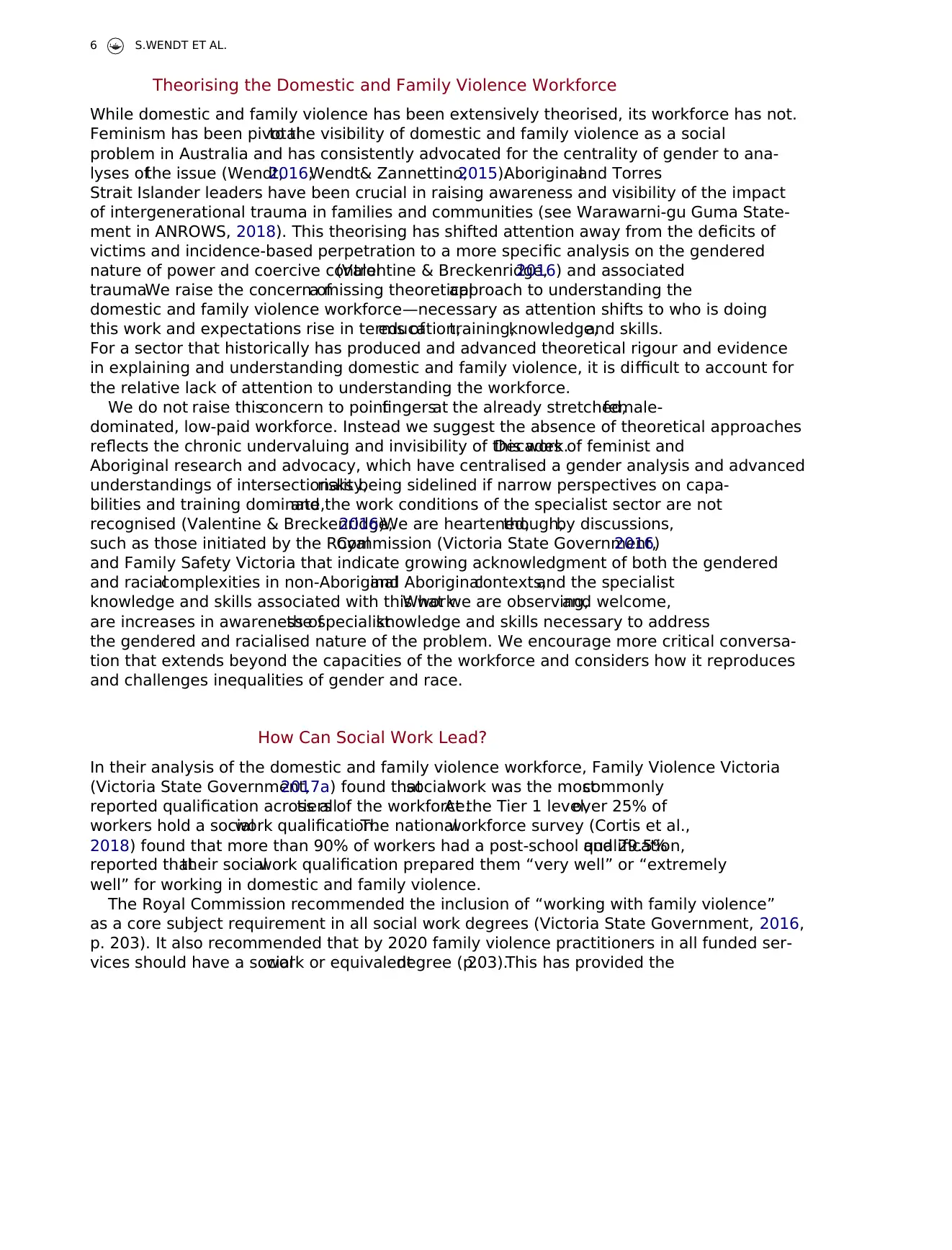
Theorising the Domestic and Family Violence Workforce
While domestic and family violence has been extensively theorised, its workforce has not.
Feminism has been pivotalto the visibility of domestic and family violence as a social
problem in Australia and has consistently advocated for the centrality of gender to ana-
lyses ofthe issue (Wendt,2016;Wendt& Zannettino,2015).Aboriginaland Torres
Strait Islander leaders have been crucial in raising awareness and visibility of the impact
of intergenerational trauma in families and communities (see Warawarni-gu Guma State-
ment in ANROWS, 2018). This theorising has shifted attention away from the deficits of
victims and incidence-based perpetration to a more specific analysis on the gendered
nature of power and coercive control(Valentine & Breckenridge,2016) and associated
trauma.We raise the concern ofa missing theoreticalapproach to understanding the
domestic and family violence workforce—necessary as attention shifts to who is doing
this work and expectations rise in terms ofeducation,training,knowledge,and skills.
For a sector that historically has produced and advanced theoretical rigour and evidence
in explaining and understanding domestic and family violence, it is difficult to account for
the relative lack of attention to understanding the workforce.
We do not raise thisconcern to pointfingersat the already stretched,female-
dominated, low-paid workforce. Instead we suggest the absence of theoretical approaches
reflects the chronic undervaluing and invisibility of this work.Decades of feminist and
Aboriginal research and advocacy, which have centralised a gender analysis and advanced
understandings of intersectionality,risks being sidelined if narrow perspectives on capa-
bilities and training dominate,and the work conditions of the specialist sector are not
recognised (Valentine & Breckenridge,2016).We are heartened,though,by discussions,
such as those initiated by the RoyalCommission (Victoria State Government,2016)
and Family Safety Victoria that indicate growing acknowledgment of both the gendered
and racialcomplexities in non-Aboriginaland Aboriginalcontexts,and the specialist
knowledge and skills associated with this work.What we are observing,and welcome,
are increases in awareness ofthe specialistknowledge and skills necessary to address
the gendered and racialised nature of the problem. We encourage more critical conversa-
tion that extends beyond the capacities of the workforce and considers how it reproduces
and challenges inequalities of gender and race.
How Can Social Work Lead?
In their analysis of the domestic and family violence workforce, Family Violence Victoria
(Victoria State Government,2017a) found thatsocialwork was the mostcommonly
reported qualification across alltiers of the workforce.At the Tier 1 level,over 25% of
workers hold a socialwork qualification.The nationalworkforce survey (Cortis et al.,
2018) found that more than 90% of workers had a post-school qualification,and 29.5%
reported thattheir socialwork qualification prepared them “very well” or “extremely
well” for working in domestic and family violence.
The Royal Commission recommended the inclusion of “working with family violence”
as a core subject requirement in all social work degrees (Victoria State Government, 2016,
p. 203). It also recommended that by 2020 family violence practitioners in all funded ser-
vices should have a socialwork or equivalentdegree (p.203).This has provided the
6 S.WENDT ET AL.
While domestic and family violence has been extensively theorised, its workforce has not.
Feminism has been pivotalto the visibility of domestic and family violence as a social
problem in Australia and has consistently advocated for the centrality of gender to ana-
lyses ofthe issue (Wendt,2016;Wendt& Zannettino,2015).Aboriginaland Torres
Strait Islander leaders have been crucial in raising awareness and visibility of the impact
of intergenerational trauma in families and communities (see Warawarni-gu Guma State-
ment in ANROWS, 2018). This theorising has shifted attention away from the deficits of
victims and incidence-based perpetration to a more specific analysis on the gendered
nature of power and coercive control(Valentine & Breckenridge,2016) and associated
trauma.We raise the concern ofa missing theoreticalapproach to understanding the
domestic and family violence workforce—necessary as attention shifts to who is doing
this work and expectations rise in terms ofeducation,training,knowledge,and skills.
For a sector that historically has produced and advanced theoretical rigour and evidence
in explaining and understanding domestic and family violence, it is difficult to account for
the relative lack of attention to understanding the workforce.
We do not raise thisconcern to pointfingersat the already stretched,female-
dominated, low-paid workforce. Instead we suggest the absence of theoretical approaches
reflects the chronic undervaluing and invisibility of this work.Decades of feminist and
Aboriginal research and advocacy, which have centralised a gender analysis and advanced
understandings of intersectionality,risks being sidelined if narrow perspectives on capa-
bilities and training dominate,and the work conditions of the specialist sector are not
recognised (Valentine & Breckenridge,2016).We are heartened,though,by discussions,
such as those initiated by the RoyalCommission (Victoria State Government,2016)
and Family Safety Victoria that indicate growing acknowledgment of both the gendered
and racialcomplexities in non-Aboriginaland Aboriginalcontexts,and the specialist
knowledge and skills associated with this work.What we are observing,and welcome,
are increases in awareness ofthe specialistknowledge and skills necessary to address
the gendered and racialised nature of the problem. We encourage more critical conversa-
tion that extends beyond the capacities of the workforce and considers how it reproduces
and challenges inequalities of gender and race.
How Can Social Work Lead?
In their analysis of the domestic and family violence workforce, Family Violence Victoria
(Victoria State Government,2017a) found thatsocialwork was the mostcommonly
reported qualification across alltiers of the workforce.At the Tier 1 level,over 25% of
workers hold a socialwork qualification.The nationalworkforce survey (Cortis et al.,
2018) found that more than 90% of workers had a post-school qualification,and 29.5%
reported thattheir socialwork qualification prepared them “very well” or “extremely
well” for working in domestic and family violence.
The Royal Commission recommended the inclusion of “working with family violence”
as a core subject requirement in all social work degrees (Victoria State Government, 2016,
p. 203). It also recommended that by 2020 family violence practitioners in all funded ser-
vices should have a socialwork or equivalentdegree (p.203).This has provided the
6 S.WENDT ET AL.
Paraphrase This Document
Need a fresh take? Get an instant paraphrase of this document with our AI Paraphraser

impetus for the Australian Association of Social Workers (AASW) to establish a credential
in this field,thereby consolidating socialworkers as lead practitioners in domestic and
family violence. The AASW’s (2018) recently released Family Violence Capability Frame-
work recognises both the unique experiences of Aboriginal and Torres Strait Islanders and
the gendered nature of domestic and family violence. Thus, social work is centrally posi-
tioned to take a leading role in advancing the conversation about domestic and family vio-
lence workforce issues and theories.
Reflecting the broader sociopolitical context, the human services sector is increasingly
characterised by constantdemand,scarce resourcing,and high pressure on front-line
workers.Despite this,research into the conditions and impacts ofthese types ofjobs
has notbeen prioritised (Kosny & MacEachen,2010).The expectations placed upon
the domestic and family violence workforce are multiplying and intensifying in line
with growing appreciation of the complexities and intersections of domestic and family
violence.We are concerned thatthe demandsplaced on workershavenot been
accompanied by a strategic focus on the nature, needs, and conditions of this very work-
force.If socialwork is to take the professionallead in responding to and working with
domestic and family violence,we argue that this must happen within the context of a
broader workforce strategy that also takes into consideration the significance of gendered
power relations, Indigeneity, high risk, trauma environments, and emotional labour in this
space.
Conclusion
Social work responses to domestic and family violence currently focus primarily on service
provision to victims and perpetrators while also advocating for changes to law and policy.
However, there is little sense in developing the service system further if such progress con-
tinues to place the workforce last in discussions about domestic and family violence. It is
disingenuous to overlook the gender and race regimes that shape the experiences,work,
and organisations associated with domestic and family violence. How can social work the-
orise domestic and family violence work that is inclusive of gender and Indigeneity and, in
doing so, inform strategising of the domestic and family violence workforce? The time for
this conversation is now.
Disclosure Statement
No potential conflict of interest was reported by the authors.
ORCID
Sarah Wendt http://orcid.org/0000-0002-1006-0299
Kris Natalier http://orcid.org/0000-0002-2867-1135
Kate Seymourhttp://orcid.org/0000-0003-4902-7776
References
Aboriginal Affairs Victoria.(2008).Strong culture,strong peoples, strong families:Towards a safer
future for Indigenous families and communities (2nd ed.).Melbourne:Department of Planning
AUSTRALIAN SOCIAL WORK 7
in this field,thereby consolidating socialworkers as lead practitioners in domestic and
family violence. The AASW’s (2018) recently released Family Violence Capability Frame-
work recognises both the unique experiences of Aboriginal and Torres Strait Islanders and
the gendered nature of domestic and family violence. Thus, social work is centrally posi-
tioned to take a leading role in advancing the conversation about domestic and family vio-
lence workforce issues and theories.
Reflecting the broader sociopolitical context, the human services sector is increasingly
characterised by constantdemand,scarce resourcing,and high pressure on front-line
workers.Despite this,research into the conditions and impacts ofthese types ofjobs
has notbeen prioritised (Kosny & MacEachen,2010).The expectations placed upon
the domestic and family violence workforce are multiplying and intensifying in line
with growing appreciation of the complexities and intersections of domestic and family
violence.We are concerned thatthe demandsplaced on workershavenot been
accompanied by a strategic focus on the nature, needs, and conditions of this very work-
force.If socialwork is to take the professionallead in responding to and working with
domestic and family violence,we argue that this must happen within the context of a
broader workforce strategy that also takes into consideration the significance of gendered
power relations, Indigeneity, high risk, trauma environments, and emotional labour in this
space.
Conclusion
Social work responses to domestic and family violence currently focus primarily on service
provision to victims and perpetrators while also advocating for changes to law and policy.
However, there is little sense in developing the service system further if such progress con-
tinues to place the workforce last in discussions about domestic and family violence. It is
disingenuous to overlook the gender and race regimes that shape the experiences,work,
and organisations associated with domestic and family violence. How can social work the-
orise domestic and family violence work that is inclusive of gender and Indigeneity and, in
doing so, inform strategising of the domestic and family violence workforce? The time for
this conversation is now.
Disclosure Statement
No potential conflict of interest was reported by the authors.
ORCID
Sarah Wendt http://orcid.org/0000-0002-1006-0299
Kris Natalier http://orcid.org/0000-0002-2867-1135
Kate Seymourhttp://orcid.org/0000-0003-4902-7776
References
Aboriginal Affairs Victoria.(2008).Strong culture,strong peoples, strong families:Towards a safer
future for Indigenous families and communities (2nd ed.).Melbourne:Department of Planning
AUSTRALIAN SOCIAL WORK 7
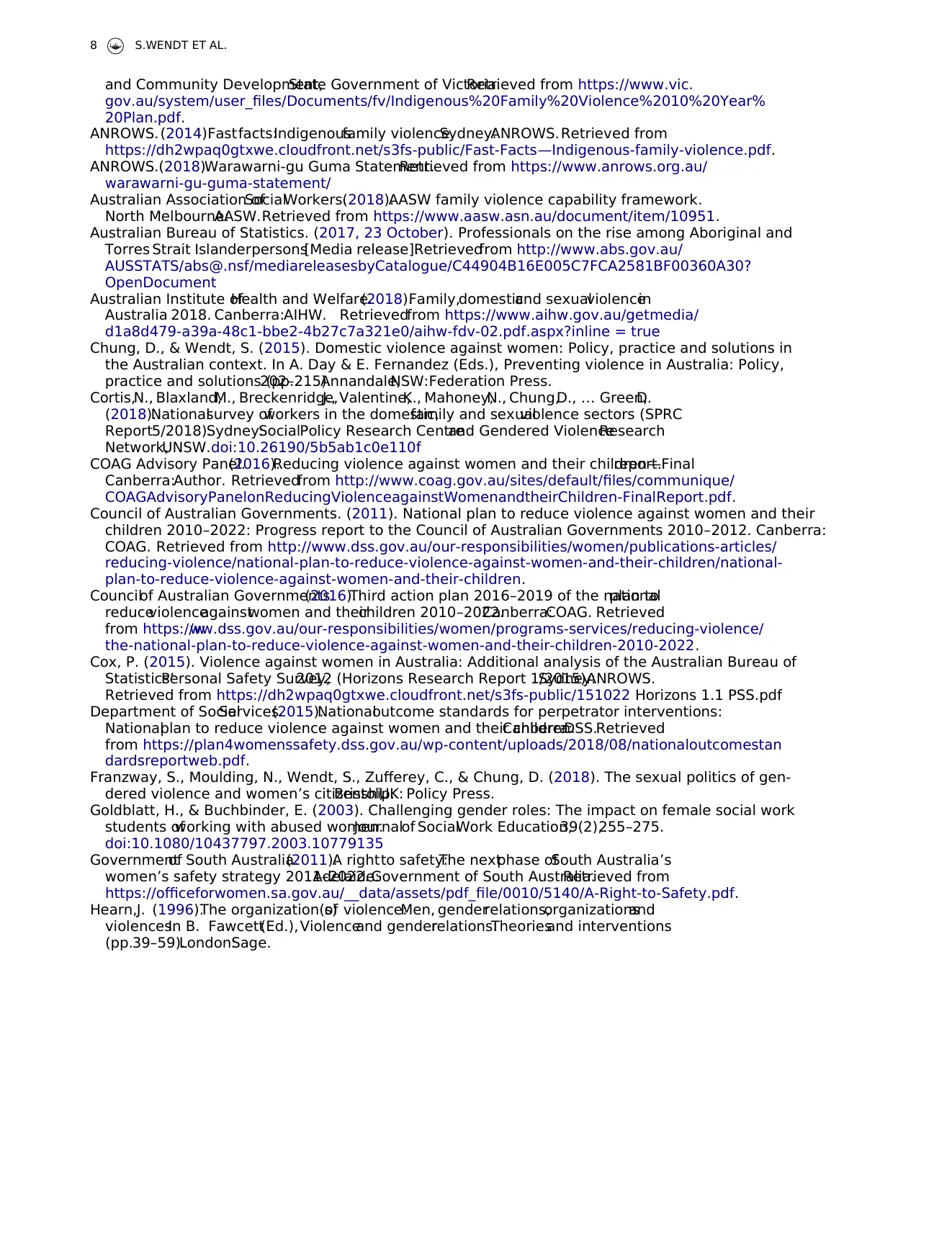
and Community Development,State Government of Victoria.Retrieved from https://www.vic.
gov.au/system/user_files/Documents/fv/Indigenous%20Family%20Violence%2010%20Year%
20Plan.pdf.
ANROWS. (2014).Fastfacts:Indigenousfamily violence.Sydney:ANROWS.Retrieved from
https://dh2wpaq0gtxwe.cloudfront.net/s3fs-public/Fast-Facts—Indigenous-family-violence.pdf.
ANROWS.(2018).Warawarni-gu Guma Statement.Retrieved from https://www.anrows.org.au/
warawarni-gu-guma-statement/
Australian Association ofSocialWorkers.(2018).AASW family violence capability framework.
North Melbourne:AASW.Retrieved from https://www.aasw.asn.au/document/item/10951.
Australian Bureau of Statistics. (2017, 23 October). Professionals on the rise among Aboriginal and
Torres Strait Islanderpersons[Media release].Retrievedfrom http://www.abs.gov.au/
AUSSTATS/abs@.nsf/mediareleasesbyCatalogue/C44904B16E005C7FCA2581BF00360A30?
OpenDocument
Australian Institute ofHealth and Welfare.(2018).Family,domesticand sexualviolencein
Australia 2018. Canberra:AIHW. Retrievedfrom https://www.aihw.gov.au/getmedia/
d1a8d479-a39a-48c1-bbe2-4b27c7a321e0/aihw-fdv-02.pdf.aspx?inline = true
Chung, D., & Wendt, S. (2015). Domestic violence against women: Policy, practice and solutions in
the Australian context. In A. Day & E. Fernandez (Eds.), Preventing violence in Australia: Policy,
practice and solutions (pp.202–215).Annandale,NSW:Federation Press.
Cortis,N., Blaxland,M., Breckenridge,J., Valentine,K., Mahoney,N., Chung,D., … Green,D.
(2018).Nationalsurvey ofworkers in the domestic,family and sexualviolence sectors (SPRC
Report5/2018).Sydney:SocialPolicy Research Centreand Gendered ViolenceResearch
Network,UNSW.doi:10.26190/5b5ab1c0e110f
COAG Advisory Panel.(2016).Reducing violence against women and their children—Finalreport.
Canberra:Author. Retrievedfrom http://www.coag.gov.au/sites/default/files/communique/
COAGAdvisoryPanelonReducingViolenceagainstWomenandtheirChildren-FinalReport.pdf.
Council of Australian Governments. (2011). National plan to reduce violence against women and their
children 2010–2022: Progress report to the Council of Australian Governments 2010–2012. Canberra:
COAG. Retrieved from http://www.dss.gov.au/our-responsibilities/women/publications-articles/
reducing-violence/national-plan-to-reduce-violence-against-women-and-their-children/national-
plan-to-reduce-violence-against-women-and-their-children.
Councilof Australian Governments.(2016).Third action plan 2016–2019 of the nationalplan to
reduceviolenceagainstwomen and theirchildren 2010–2022.Canberra:COAG. Retrieved
from https://www.dss.gov.au/our-responsibilities/women/programs-services/reducing-violence/
the-national-plan-to-reduce-violence-against-women-and-their-children-2010-2022.
Cox, P. (2015). Violence against women in Australia: Additional analysis of the Australian Bureau of
Statistics’Personal Safety Survey,2012 (Horizons Research Report 1/2015).Sydney:ANROWS.
Retrieved from https://dh2wpaq0gtxwe.cloudfront.net/s3fs-public/151022 Horizons 1.1 PSS.pdf
Department of SocialServices.(2015).Nationaloutcome standards for perpetrator interventions:
Nationalplan to reduce violence against women and their children.Canberra:DSS.Retrieved
from https://plan4womenssafety.dss.gov.au/wp-content/uploads/2018/08/nationaloutcomestan
dardsreportweb.pdf.
Franzway, S., Moulding, N., Wendt, S., Zufferey, C., & Chung, D. (2018). The sexual politics of gen-
dered violence and women’s citizenship.Bristol,UK: Policy Press.
Goldblatt, H., & Buchbinder, E. (2003). Challenging gender roles: The impact on female social work
students ofworking with abused women.Journalof SocialWork Education,39(2),255–275.
doi:10.1080/10437797.2003.10779135
Governmentof South Australia.(2011).A rightto safety:The nextphase ofSouth Australia’s
women’s safety strategy 2011–2022.Adelaide:Government of South Australia.Retrieved from
https://officeforwomen.sa.gov.au/__data/assets/pdf_file/0010/5140/A-Right-to-Safety.pdf.
Hearn,J. (1996).The organization(s)of violence:Men, genderrelations,organizationsand
violences.In B. Fawcett(Ed.), Violenceand genderrelations:Theoriesand interventions
(pp.39–59).London:Sage.
8 S.WENDT ET AL.
gov.au/system/user_files/Documents/fv/Indigenous%20Family%20Violence%2010%20Year%
20Plan.pdf.
ANROWS. (2014).Fastfacts:Indigenousfamily violence.Sydney:ANROWS.Retrieved from
https://dh2wpaq0gtxwe.cloudfront.net/s3fs-public/Fast-Facts—Indigenous-family-violence.pdf.
ANROWS.(2018).Warawarni-gu Guma Statement.Retrieved from https://www.anrows.org.au/
warawarni-gu-guma-statement/
Australian Association ofSocialWorkers.(2018).AASW family violence capability framework.
North Melbourne:AASW.Retrieved from https://www.aasw.asn.au/document/item/10951.
Australian Bureau of Statistics. (2017, 23 October). Professionals on the rise among Aboriginal and
Torres Strait Islanderpersons[Media release].Retrievedfrom http://www.abs.gov.au/
AUSSTATS/abs@.nsf/mediareleasesbyCatalogue/C44904B16E005C7FCA2581BF00360A30?
OpenDocument
Australian Institute ofHealth and Welfare.(2018).Family,domesticand sexualviolencein
Australia 2018. Canberra:AIHW. Retrievedfrom https://www.aihw.gov.au/getmedia/
d1a8d479-a39a-48c1-bbe2-4b27c7a321e0/aihw-fdv-02.pdf.aspx?inline = true
Chung, D., & Wendt, S. (2015). Domestic violence against women: Policy, practice and solutions in
the Australian context. In A. Day & E. Fernandez (Eds.), Preventing violence in Australia: Policy,
practice and solutions (pp.202–215).Annandale,NSW:Federation Press.
Cortis,N., Blaxland,M., Breckenridge,J., Valentine,K., Mahoney,N., Chung,D., … Green,D.
(2018).Nationalsurvey ofworkers in the domestic,family and sexualviolence sectors (SPRC
Report5/2018).Sydney:SocialPolicy Research Centreand Gendered ViolenceResearch
Network,UNSW.doi:10.26190/5b5ab1c0e110f
COAG Advisory Panel.(2016).Reducing violence against women and their children—Finalreport.
Canberra:Author. Retrievedfrom http://www.coag.gov.au/sites/default/files/communique/
COAGAdvisoryPanelonReducingViolenceagainstWomenandtheirChildren-FinalReport.pdf.
Council of Australian Governments. (2011). National plan to reduce violence against women and their
children 2010–2022: Progress report to the Council of Australian Governments 2010–2012. Canberra:
COAG. Retrieved from http://www.dss.gov.au/our-responsibilities/women/publications-articles/
reducing-violence/national-plan-to-reduce-violence-against-women-and-their-children/national-
plan-to-reduce-violence-against-women-and-their-children.
Councilof Australian Governments.(2016).Third action plan 2016–2019 of the nationalplan to
reduceviolenceagainstwomen and theirchildren 2010–2022.Canberra:COAG. Retrieved
from https://www.dss.gov.au/our-responsibilities/women/programs-services/reducing-violence/
the-national-plan-to-reduce-violence-against-women-and-their-children-2010-2022.
Cox, P. (2015). Violence against women in Australia: Additional analysis of the Australian Bureau of
Statistics’Personal Safety Survey,2012 (Horizons Research Report 1/2015).Sydney:ANROWS.
Retrieved from https://dh2wpaq0gtxwe.cloudfront.net/s3fs-public/151022 Horizons 1.1 PSS.pdf
Department of SocialServices.(2015).Nationaloutcome standards for perpetrator interventions:
Nationalplan to reduce violence against women and their children.Canberra:DSS.Retrieved
from https://plan4womenssafety.dss.gov.au/wp-content/uploads/2018/08/nationaloutcomestan
dardsreportweb.pdf.
Franzway, S., Moulding, N., Wendt, S., Zufferey, C., & Chung, D. (2018). The sexual politics of gen-
dered violence and women’s citizenship.Bristol,UK: Policy Press.
Goldblatt, H., & Buchbinder, E. (2003). Challenging gender roles: The impact on female social work
students ofworking with abused women.Journalof SocialWork Education,39(2),255–275.
doi:10.1080/10437797.2003.10779135
Governmentof South Australia.(2011).A rightto safety:The nextphase ofSouth Australia’s
women’s safety strategy 2011–2022.Adelaide:Government of South Australia.Retrieved from
https://officeforwomen.sa.gov.au/__data/assets/pdf_file/0010/5140/A-Right-to-Safety.pdf.
Hearn,J. (1996).The organization(s)of violence:Men, genderrelations,organizationsand
violences.In B. Fawcett(Ed.), Violenceand genderrelations:Theoriesand interventions
(pp.39–59).London:Sage.
8 S.WENDT ET AL.
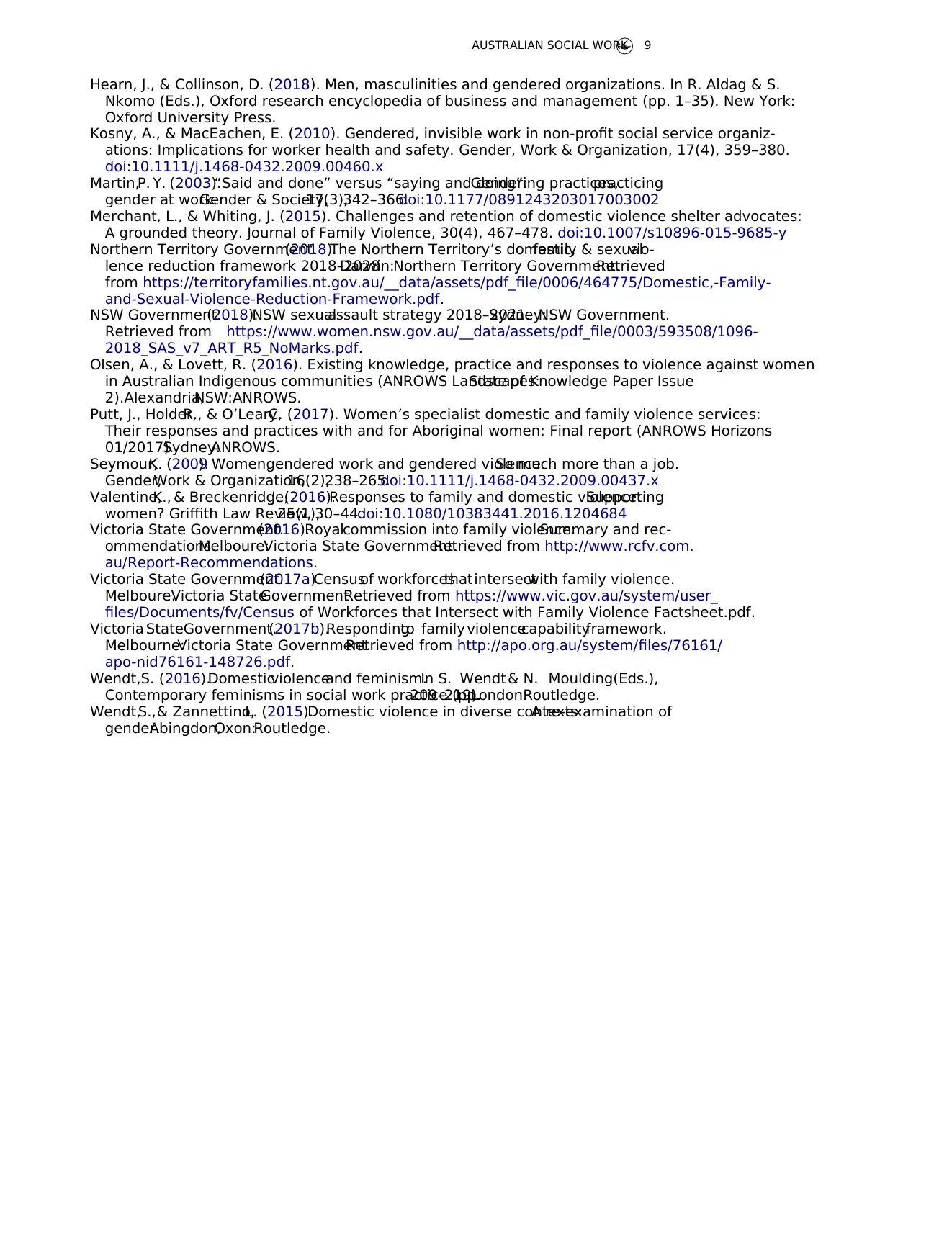
Hearn, J., & Collinson, D. (2018). Men, masculinities and gendered organizations. In R. Aldag & S.
Nkomo (Eds.), Oxford research encyclopedia of business and management (pp. 1–35). New York:
Oxford University Press.
Kosny, A., & MacEachen, E. (2010). Gendered, invisible work in non-profit social service organiz-
ations: Implications for worker health and safety. Gender, Work & Organization, 17(4), 359–380.
doi:10.1111/j.1468-0432.2009.00460.x
Martin,P. Y. (2003).“Said and done” versus “saying and doing”:Gendering practices,practicing
gender at work.Gender & Society,17(3),342–366.doi:10.1177/0891243203017003002
Merchant, L., & Whiting, J. (2015). Challenges and retention of domestic violence shelter advocates:
A grounded theory. Journal of Family Violence, 30(4), 467–478. doi:10.1007/s10896-015-9685-y
Northern Territory Government.(2018).The Northern Territory’s domestic,family & sexualvio-
lence reduction framework 2018–2028.Darwin:Northern Territory Government.Retrieved
from https://territoryfamilies.nt.gov.au/__data/assets/pdf_file/0006/464775/Domestic,-Family-
and-Sexual-Violence-Reduction-Framework.pdf.
NSW Government.(2018).NSW sexualassault strategy 2018–2021.Sydney:NSW Government.
Retrieved from https://www.women.nsw.gov.au/__data/assets/pdf_file/0003/593508/1096-
2018_SAS_v7_ART_R5_NoMarks.pdf.
Olsen, A., & Lovett, R. (2016). Existing knowledge, practice and responses to violence against women
in Australian Indigenous communities (ANROWS Landscapes:State of Knowledge Paper Issue
2).Alexandria,NSW:ANROWS.
Putt, J., Holder,R., & O’Leary,C. (2017). Women’s specialist domestic and family violence services:
Their responses and practices with and for Aboriginal women: Final report (ANROWS Horizons
01/2017).Sydney:ANROWS.
Seymour,K. (2009). Women,gendered work and gendered violence:So much more than a job.
Gender,Work & Organization,16(2),238–265.doi:10.1111/j.1468-0432.2009.00437.x
Valentine,K., & Breckenridge,J. (2016).Responses to family and domestic violence:Supporting
women? Griffith Law Review,25(1),30–44.doi:10.1080/10383441.2016.1204684
Victoria State Government.(2016).Royalcommission into family violence:Summary and rec-
ommendations.Melboure:Victoria State Government.Retrieved from http://www.rcfv.com.
au/Report-Recommendations.
Victoria State Government.(2017a).Censusof workforcesthatintersectwith family violence.
Melboure:Victoria StateGovernment.Retrieved from https://www.vic.gov.au/system/user_
files/Documents/fv/Census of Workforces that Intersect with Family Violence Factsheet.pdf.
Victoria StateGovernment.(2017b).Respondingto family violencecapabilityframework.
Melbourne:Victoria State Government.Retrieved from http://apo.org.au/system/files/76161/
apo-nid76161-148726.pdf.
Wendt,S. (2016).Domesticviolenceand feminism.In S. Wendt& N. Moulding(Eds.),
Contemporary feminisms in social work practice (pp.209–219).London:Routledge.
Wendt,S.,& Zannettino,L. (2015).Domestic violence in diverse contexts:A re-examination of
gender.Abingdon,Oxon:Routledge.
AUSTRALIAN SOCIAL WORK 9
Nkomo (Eds.), Oxford research encyclopedia of business and management (pp. 1–35). New York:
Oxford University Press.
Kosny, A., & MacEachen, E. (2010). Gendered, invisible work in non-profit social service organiz-
ations: Implications for worker health and safety. Gender, Work & Organization, 17(4), 359–380.
doi:10.1111/j.1468-0432.2009.00460.x
Martin,P. Y. (2003).“Said and done” versus “saying and doing”:Gendering practices,practicing
gender at work.Gender & Society,17(3),342–366.doi:10.1177/0891243203017003002
Merchant, L., & Whiting, J. (2015). Challenges and retention of domestic violence shelter advocates:
A grounded theory. Journal of Family Violence, 30(4), 467–478. doi:10.1007/s10896-015-9685-y
Northern Territory Government.(2018).The Northern Territory’s domestic,family & sexualvio-
lence reduction framework 2018–2028.Darwin:Northern Territory Government.Retrieved
from https://territoryfamilies.nt.gov.au/__data/assets/pdf_file/0006/464775/Domestic,-Family-
and-Sexual-Violence-Reduction-Framework.pdf.
NSW Government.(2018).NSW sexualassault strategy 2018–2021.Sydney:NSW Government.
Retrieved from https://www.women.nsw.gov.au/__data/assets/pdf_file/0003/593508/1096-
2018_SAS_v7_ART_R5_NoMarks.pdf.
Olsen, A., & Lovett, R. (2016). Existing knowledge, practice and responses to violence against women
in Australian Indigenous communities (ANROWS Landscapes:State of Knowledge Paper Issue
2).Alexandria,NSW:ANROWS.
Putt, J., Holder,R., & O’Leary,C. (2017). Women’s specialist domestic and family violence services:
Their responses and practices with and for Aboriginal women: Final report (ANROWS Horizons
01/2017).Sydney:ANROWS.
Seymour,K. (2009). Women,gendered work and gendered violence:So much more than a job.
Gender,Work & Organization,16(2),238–265.doi:10.1111/j.1468-0432.2009.00437.x
Valentine,K., & Breckenridge,J. (2016).Responses to family and domestic violence:Supporting
women? Griffith Law Review,25(1),30–44.doi:10.1080/10383441.2016.1204684
Victoria State Government.(2016).Royalcommission into family violence:Summary and rec-
ommendations.Melboure:Victoria State Government.Retrieved from http://www.rcfv.com.
au/Report-Recommendations.
Victoria State Government.(2017a).Censusof workforcesthatintersectwith family violence.
Melboure:Victoria StateGovernment.Retrieved from https://www.vic.gov.au/system/user_
files/Documents/fv/Census of Workforces that Intersect with Family Violence Factsheet.pdf.
Victoria StateGovernment.(2017b).Respondingto family violencecapabilityframework.
Melbourne:Victoria State Government.Retrieved from http://apo.org.au/system/files/76161/
apo-nid76161-148726.pdf.
Wendt,S. (2016).Domesticviolenceand feminism.In S. Wendt& N. Moulding(Eds.),
Contemporary feminisms in social work practice (pp.209–219).London:Routledge.
Wendt,S.,& Zannettino,L. (2015).Domestic violence in diverse contexts:A re-examination of
gender.Abingdon,Oxon:Routledge.
AUSTRALIAN SOCIAL WORK 9
1 out of 10
Related Documents
Your All-in-One AI-Powered Toolkit for Academic Success.
+13062052269
info@desklib.com
Available 24*7 on WhatsApp / Email
![[object Object]](/_next/static/media/star-bottom.7253800d.svg)
Unlock your academic potential
© 2024 | Zucol Services PVT LTD | All rights reserved.
